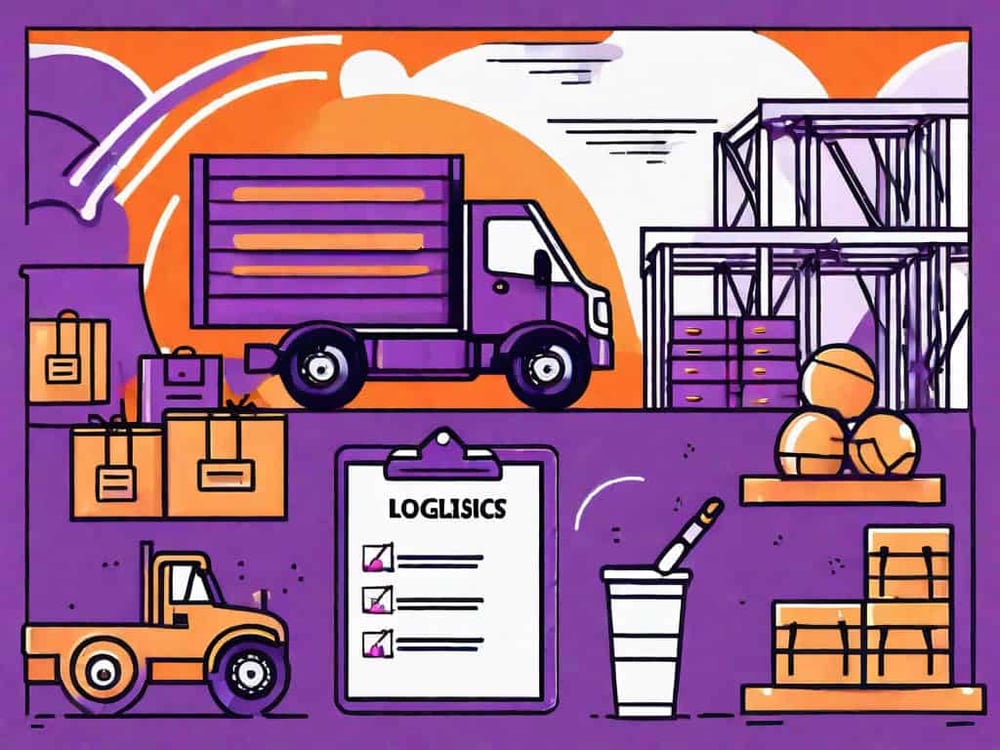Did you know that businesses using Fulfyld as their 3PL provider can save up to 25% more over four years, all while maintaining high service quality?
Our 3PL evaluation template helps you streamline the selection process, ensuring you make the best decision for your business needs. Download it for free and get started today!
Table of Contents
ToggleWhat Is a 3PL Evaluation Template and How to Use It?
A 3PL and warehouse RFP template is a structured tool designed to help businesses assess and compare potential third-party logistics providers.
To help you visualize the journey of selecting the right 3PL partner for your business, we’ve created a comprehensive flowchart. This visual guide outlines the key steps involved in the selection process, from defining your requirements to the final implementation and onboarding.
This flowchart illustrates the nine crucial stages in selecting a 3PL provider:
- Define Requirements: Clearly outline your logistics needs and business objectives.
- Research Potential 3PLs: Identify and investigate potential 3PL partners that align with your requirements.
- Create RFP: Develop a detailed Request for Proposal (RFP) to solicit bids from 3PL providers.
- Send RFP to Shortlisted 3PLs: Distribute your RFP to the most promising candidates.
- Evaluate Responses: Analyze and compare the proposals received from potential 3PL partners.
- Conduct Site Visits: Visit the facilities of your top choices to assess their operations firsthand.
- Negotiate Contract: Discuss and finalize terms with your preferred 3PL provider(s).
- Select 3PL Partner: Make your final decision based on all gathered information and negotiations.
- Implement and Onboard: Begin the process of integrating the chosen 3PL into your supply chain operations.
Each step in this process is crucial and builds upon the previous ones, ensuring a thorough and strategic approach to selecting the best 3PL partner for your business. As you progress through this document, we’ll delve deeper into each of these stages, providing you with the knowledge and tools needed to make an informed decision.
It breaks down the key criteria, such as service capabilities, pricing, technology, and customer support, making it easier to analyze and weigh each provider’s offerings side by side.
By using this template, companies can ensure they’re gathering consistent, comprehensive information that will guide them toward making the best decision for their logistics needs.
Download our easy-to-use 3PL evaluation template to simplify your search for the perfect partner.
Get your template HERE and start comparing providers today!
What Key Factors Should Be Included in a 3PL RFP Template?
When crafting a 3PL RFP template, we included several key components to ensure you gather all the information you need to make an informed decision. These include:
- Company Background and Objectives
- Scope of Work and Requirements
- Pricing and Contract Terms
- Key Criteria for Evaluation
Company Background and Objectives
Start your RFP by providing a brief overview of your company. This will help potential 3PL providers understand your business and its unique logistical challenges. Include details such as:
- your industry
- products or services
- any specific markets you operate in
By sharing this information, you can give vendors a better understanding of your business and its needs.
Define Your Business Objectives
When crafting your 3PL RFP, it’s essential to begin with a clear overview of your company and your business goals.
- The Company Overview section should give vendors a snapshot of your business, including what you offer and your target market.
- The Business Objectives should clearly outline your priorities for partnering with a provider, whether it’s cost reduction, faster deliveries, or market expansion.
This will ensure that you find a provider that can meet your specific needs and contribute to your business growth.
Scope of Work and Requirements
Clearly defining the scope of work and the specific logistics services you require is crucial in a 3PL RFP.
- In the Logistics Services Required section, detail the services you need, such as transportation services, warehousing and distribution, or reverse logistics.
- The Industry Certifications section should outline any certifications (e.g., hazardous materials handling) or compliance standards that are essential for your business or industry.
Pricing and Contract Terms
Clearly outlining your expectations regarding the pricing model and contract terms is essential in a 3PL RFP.
- Pricing Model: This section helps vendors understand whether you are looking for a fixed price or performance-based pricing model, ensuring alignment with your financial expectations.
- Contract Terms: Define the specific terms and conditions that should be included in the agreement, such as performance metrics, penalties for non-compliance, and payment terms.
Key Criteria for Evaluation
For the final verdict on whether the provider is the right choice for you, you need to ask several questions that can make or break your potential cooperation with them. Let’s discuss them in more details.
Technology Capabilities
When evaluating a 3PL provider’s technology capabilities, it’s crucial to understand the impact of advanced technology on performance and efficiency.
As John Langley, Professor of Supply Chain Management at Penn State University, notes, “The integration of cutting-edge technology in 3PL operations is no longer a luxury—it’s a necessity for staying competitive in today’s fast-paced logistics landscape.”
According to the 2023 Third-Party Logistics Study by Capgemini:
- 93% of shippers and 99% of 3PL providers agree that IT capabilities are a necessary element of 3PL expertise.
- 3PLs that have implemented advanced analytics solutions reported a 15% increase in overall operational efficiency.
- 78% of shippers reported that 3PLs with robust technology capabilities delivered a tangible positive impact on their supply chain performance.
Request a detailed explanation of the technology systems the 3PL provider uses. This should include:
- warehouse management systems (WMS)
- order management systems (OMS)
- any integrations with e-commerce platforms or enterprise resource planning (ERP) systems
Effective technology ensures real-time tracking and enhances communication between your business and the 3PL provider.
As Evan Armstrong, President of Armstrong & Associates, emphasizes, “The most successful 3PLs are those that can offer a comprehensive, integrated technology solution that not only manages day-to-day operations but also provides actionable insights for continuous improvement.”
Scalability
Assess the provider’s ability to grow alongside your business. Ask for examples of how they have managed seasonal spikes or rapid expansion for other clients. Understanding their capacity to scale ensures they can handle future growth without compromising service quality.
3PL Audit Checklist
The 3PL audit checklist includes key areas such as:
- compliance with industry standards
- ensuring the provider meets all regulations
- financial stability to confirm long-term reliability
- operational capacity for handling your logistics needs
- customer references to verify service quality from past clients
Common Challenges that 3PL Implementation Checklist Addresses
When onboarding a new 3PL partner, ecommerce businesses often encounter several challenges that can disrupt operations if not managed carefully. So, if you’re wondering What common challenges does a 3PL implementation checklist help address, here are the 3 main ones that we identified.
- Misaligned Expectations: Without clear communication, both parties may have different expectations regarding timelines, deliverables, and performance metrics. The checklist ensures all objectives are defined upfront, avoiding misunderstandings during the implementation process.
- Technology Integration Issues: Integrating the 3PL’s systems with your own can be a technical hurdle. The checklist provides steps for smooth system alignment, reducing the risk of data errors, delays, or compatibility problems.
- Operational Disruptions: During the transition, disruptions in inventory management, shipping, or customer service can arise. The checklist establishes protocols to handle these critical areas efficiently, ensuring minimal impact on daily operations.
Common Mistakes to Avoid
While writing an effective 3PL RFP is important, there are several common mistakes you should avoid:
- Being too vague or ambiguous about your requirements
One major mistake is providing unclear or incomplete information in your RFP, which can lead to miscommunications with potential vendors. This often results in proposals that do not align with your actual needs.
To avoid this:
- Be specific and detailed when outlining your requirements.
- Provide examples or scenarios to clarify what you’re looking for.
- Overemphasizing price over other important factors
While price is an important factor, focusing solely on cost can lead to choosing a vendor that might not deliver on quality or experience.
Instead:
- Evaluate proposals holistically, considering factors like vendor track record and industry expertise.
- Prioritize a balance of quality, experience, and price to find the best fit for your needs.
- Not thoroughly evaluating vendor proposals or conducting reference checks
Failing to thoroughly assess vendor proposals or check references can result in selecting an unsuitable partner. It’s essential to dive deep into the details of each proposal.
To ensure the right fit:
- Compare proposals carefully against your specific requirements.
- Conduct reference checks to verify the vendor’s reliability and performance history.
- Being inflexible with contract terms or negotiation
Being too rigid in your contract terms can limit your options, potentially excluding vendors who may be otherwise ideal partners.
To avoid this:
- Keep clear expectations, but remain open to negotiation.
- Consider flexible contract terms that accommodate both parties’ needs for a successful long-term partnership.
Making the Final Decision
Based on your evaluation of the responses, shortlist the most suitable vendors and proceed with conducting further due diligence. Consider conducting site visits, requesting references, and engaging in contract negotiations to finalize your decision.
Choosing the right 3PL partner is a critical decision that can have a significant impact on your business’s success. By following the steps outlined in this article, and utilizing a well-crafted 3PL RFP with the help of a template, you can find the perfect partner who will help optimize your supply chain and drive growth.
FAQs
How to evaluate 3PL?
Evaluating a 3PL involves comparing providers across key areas such as service capabilities, pricing, technology, and customer support. Use an evaluation template to gather consistent information, allowing you to make a well-informed decision based on your business needs.
How do you monitor logistics performance?
Logistics performance can be monitored using key performance indicators (KPIs) such as order accuracy, delivery speed, and inventory management. Regular reports from your 3PL provider and system integrations that track real-time data help ensure you stay on top of logistics performance.
How can an RFP checklist improve the 3PL selection process?
An RFP checklist streamlines the 3PL selection process by ensuring that all critical factors are considered. It helps gather structured responses from potential partners, making it easier to compare their services, capabilities, and alignment with your business needs.
How often should a 3PL audit be conducted, and what should it cover?
A 3PL audit should be conducted at least once a year, or more frequently if your business is growing rapidly. It should cover compliance with industry standards, operational capacity, financial stability, and customer service performance to ensure your provider continues to meet your requirements.
How can 3PLs adapt to seasonal demand fluctuations?
3PLs can adapt to seasonal demand fluctuations by offering scalable solutions like flexible warehousing and increased labor resources during peak times. A well-established 3PL should be able to adjust their operations to handle surges in order volume without compromising service quality.






